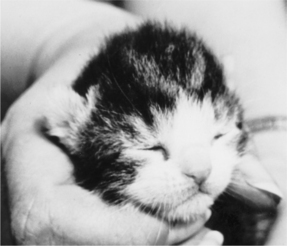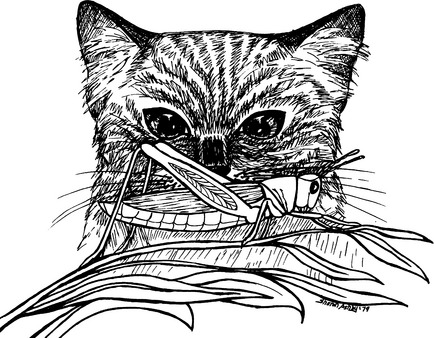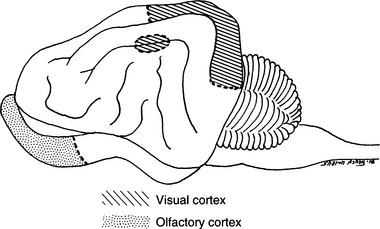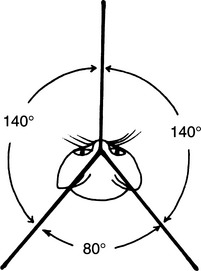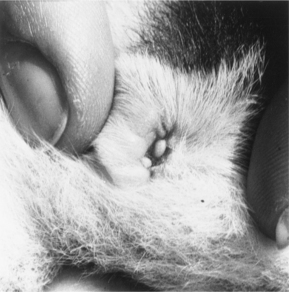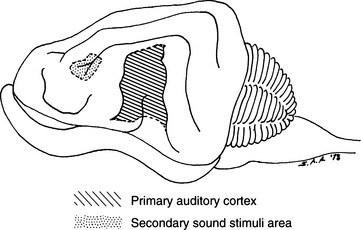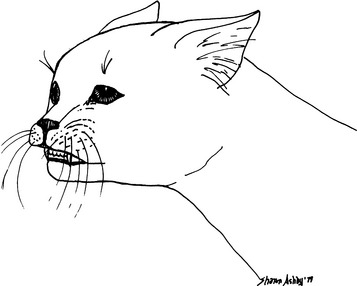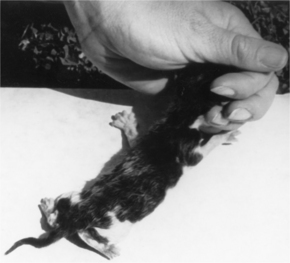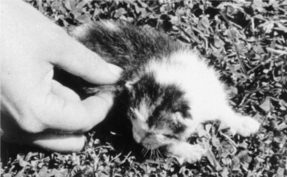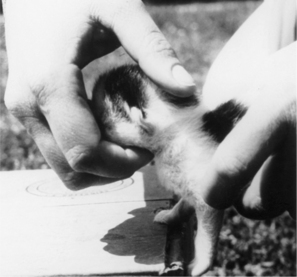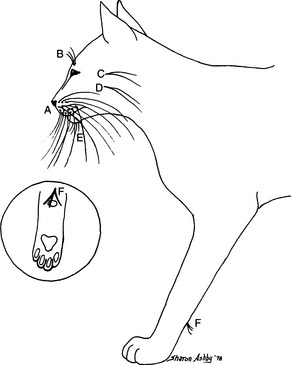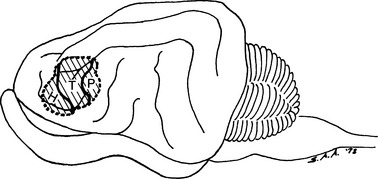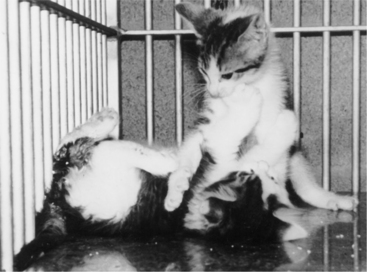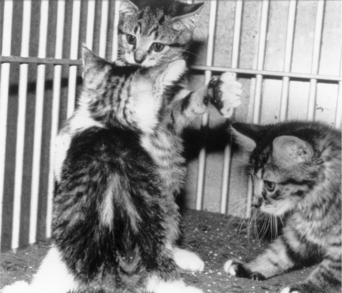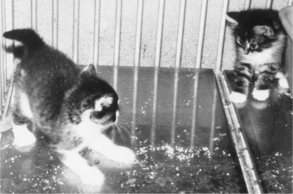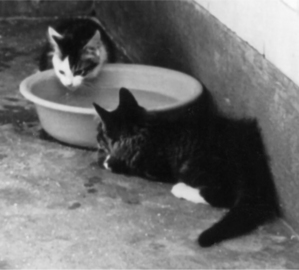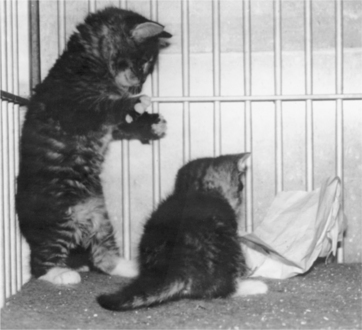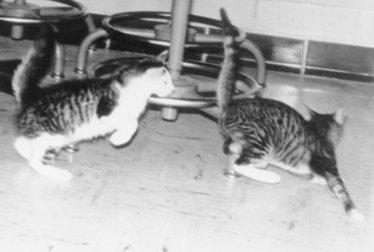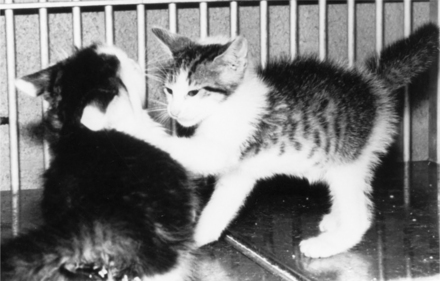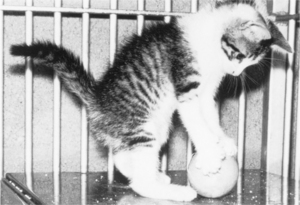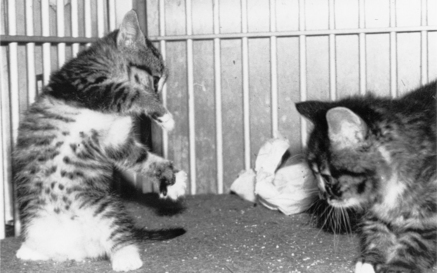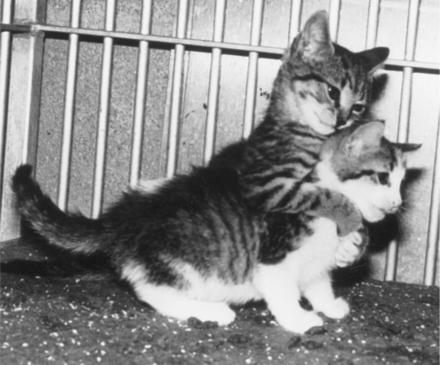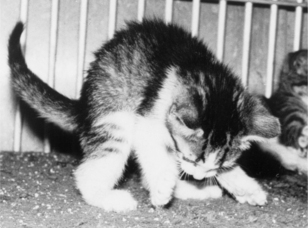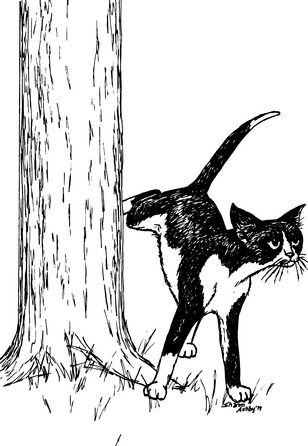Chapter 2 Feline Behavior of Sensory and Neural Origin
Studying the senses of an animal is extremely difficult because we as humans are limited by our own sensory capacities. It is difficult to understand that which cannot be experienced. Mammalian senses differ greatly, developing primarily to meet biologic needs. Thus the importance of each will vary among the species. The cat has served as a scientific model for neuroanatomic studies, so we are fortunate to know more about its senses and neurologic connections than those of most other animals.
THE SENSES
Comparative development of the senses is shown in Appendix B.
Sense of Vision
External visual system development
Like the young of several other species, the newborn kitten is care dependent at birth and for several weeks thereafter. This immature state is reflected in the visual system, which needs postnatal time for development. At birth the kitten’s ocular development is approximately equivalent to that of a 5-month-old human fetus. Continued development happens even though the eyes are sealed until 5 to 14 days after birth (mean 8 days).92,172,212 At first the eye opens only slightly, but by 17 days (mean 9 days) both eyes are completely open (Figure 2-1). Several factors can influence when the opening begins. Early handling can accelerate this process by approximately 24 hours.81,112 Other factors include genetic influences from the sire, exposure to light (dark reared open earlier), sex of the kitten (females open earlier than males), and age of the mother (young mothers result in earlier opening).172 Anatomic changes in vascularization occur in about 3 weeks and result in a sudden improvement in the kitten’s visual optics.251 Although visual electrical potentials can be recorded from the cortex of the brain as early as 4 days of age and the first electroretinogram can be recorded at day 6, neither becomes adultlike until week 9 or 10.76
A few reflexes associated with vision appear before the opening of the eyes. The palpebral reflex starts as a slow blink response during the first 3 days of life, becoming adultlike by the ninth day. The light blink reflex develops as early as day 50 of gestation or as late as day 13 of postnatal life (mean 6 days postnatal life). Although the palpebral reflex continues, the light blink reflex disappears around 21 days, probably because of the development of acute pupil control. Pupillary response generally appears within 24 hours after the eyes open, taking 2 or 3 days to develop normal speed. Until this time the kitten usually tries to turn its head away from the light source.
Visual acuity develops independently of the opening of the eyes.268 Visual pursuit first occurs as an eye-turning and head-turning action at about 11 days, when kittens first visually follow people and moving objects. Visual acuity, measured in terms of visual angles, gradually improves from a 180-minute arc around 16 days to a 43-minute arc about 21 days, and then to an 11-minute arc around 25 days.268 Between 22 and 28 days (mean 25 days) visual placing reactions of the forelimbs first occur and are significantly related to good visual acuity.53,268 There is a sixteenfold overall increase of visual acuity between 2 and 10 weeks of age.235
Depth perception initially appears a few days after the eyes open (mean 13 days) and is well developed by 4 weeks of age. With continued maturation of the visual system, the kitten gradually increases the use of its eyes for behaviors such as avoiding objects and finding food, with good binocular vision by 47 days.261 There is an accompanying sudden onset of light-seeking behavior at 2 months of age.61 By this time the kitten has adult sight capacities, even though the visual system continues its development for another 2 months.92,160
Eye color starts changing around 23 days of age, but early handling can speed this up slightly.112
External visual system characteristics
Physical features of the typical eye are species specific. In the cat the dimensions of the globe are 20 to 22 mm in the anteroposterior direction, 19 to 20.7 mm on the vertical axis, and 18 to 21 mm transversely. This makes the adult cat slightly myopic (+4.73S).76,208 Because of eye shape and pupil extremes, both the lens and the cornea of cats are larger and more highly curved than their counterparts in the human.32,71 The cornea composes up to 30% of the outer layer of the eye.208 The tapetum lucidum is relatively thick at 2 μm, with an average of 12 to 15 layers.47,208,266 The more superficial layers of the tapetum tend to reflect shorter wavelengths; deeper layers reflect longer wavelengths.47 The retinal fovea (macula, area centralis), the area of most acute vision, cannot be identified before 5 weeks of age.76 In the adult, it is located a mean distance of 3.42 mm dorsolateral from the center of the optic disc.26,56 Although cones are most concentrated here, this area in the cat is relatively large and indefinite because both cones and rods are present.19,52,138,141,280 In the human, there are only cones in the area of the fovea. Each feline eye has a blind spot on the dorsolateral retina at 13 degrees lateral.26,260
Because the feline adult visual and behavioral characteristics are closely related, it is important to note the anatomic adaptations that make night hunting possible. As a result of the large lens and cornea, the eye can collect more light, there is a larger visual field, and a relatively large portion of the retina is activated.208 The tapetum lucidum reflects light within the eye for maximal stimulation of the rods in the retina. In addition to the many low-threshold rods (rod/cone ratio is 25:1 as compared with 20:1 in humans), the cat eye also has more layers of sensitive cells in the retina.72,114 These retinal differences allow cats to use up to 50% more of the available light than humans and have vision in one sixth the illumination needed by humans. The cat has an absolute brightness threshold of 1.32×10−7 millilamberts.175
Other changes occur to protect the eye from being overstimulated by sunlight. The ability of the pupil to become a very narrow slit rapidly is typically found in nocturnal animals that also bask in the sun.266 While the tapetum reflects light, the remainder of the fundus is heavily pigmented, particularly in the lower half. This protects the sensitive retina from overhead glare.207 In addition, the rods have the ability to adapt so that they do not saturate with light before the cones take over vision in higher light intensities.249
Visual acuity is most accurate at 75 cm but is compromised for night-hunting abilities.138,238 The visual acuity of the cat matures from slightly more than one cycle per degree at 35 days of age to five to six cycles per degree at 4 months, to eight to nine cycles per degree as an adult.72,142,180,274 These figures are 10% those of humans.29,72 The low level of visual acuity is due to three internal factors: Reflection by the tapetum lucidum blurs the image; the increased number of rods decreases the resolution of the image by lowering the visual stimulus threshold; and the lens loses one half to one third of its capacity for accommodation.266 Accommodation does, however, relate to the significance of the viewed subject.69 Although some retinal ganglion cells are comparable to those in humans, the brain is apparently unable to use incoming information to the same degree.226 In spite of its slight myopia the cat shows a marked ability to notice movement, a necessity in hunting behaviors.19,69 Thresholds to recognize real movement are as little as a 0.4-cm/sec movement.153
The iris has a prominent bulging shape and can change colors during sympathetic stimulation.139,240
The cat is generally considered color blind. There are cones present in the retina and there are a few spectral opponent ganglia.257 Considering the anatomy as a whole, however, cat eyes are not specialized for color vision. Experimental evidence shows that cats can perceive only limited color. The photopic wavelength sensitivity is dichromat, meaning the cat is most sensitive around two wavelengths. At long wavelengths, they are most responsive at 554 nm, a greenish yellow, which is maximally sensitive to the cat’s most common cones.167 At the shorter wavelength, cats respond around 447 nm, in the blue area.167 It also seems necessary that background illumination be greater than 3.0 cd/m2 so as not to be a factor in getting appropriate test results.167 It is generally agreed that color vision, although possible, is of little natural importance to the cat. Further evidence of this is suggested by the relatively low number of cones compared with rods in the retina as a whole.280 Brightness is of much greater significance than color in visual discrimination, allowing the cat to detect luminance differences of only 10% to 12%.274 They can perceive illumination at one fifth the threshold of humans.132
Binocular vision is important for hunting success of this predator because its prey tend to be small and quick. Because of eye position and head shape, each eye has a visual field between 155 and 208.5 degrees, of which 90 to 130 degrees overlap the visual field of the opposite eye to produce binocular vision (Figure 2-2).19,52,72,229,232 The remaining 73- to 173-degree field behind the head is a blind area. To provide this much binocular vision, the median plane of the eye is at an angle of only 4 to 9 degrees from that of the body.52,72 In kittens this alignment of the optic axes is quite divergent, but it becomes almost parallel within a few months.228,264 About 40% of the cats studied show no convergence of both eyes while examining close objects, although with certain lifestyles such as hunting insects, this percentage may decrease (Figure 2-3).138
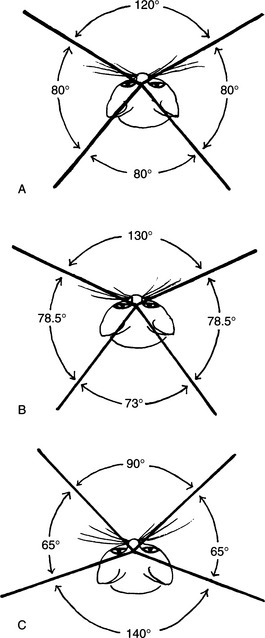
Figure 2-2 Visual fields of binocular, uniocular, and blind vision.
(A data from Beadle M: The cat: history, biology, and behavior, New York, 1977, Simon & Schuster; B data from Ewer RF: The carnivores, Ithaca, NY, 1973, Cornell University Press; C data from Sherman SM: Brain Res 49:25–45, Jan 15, 1973.)
Internal visual system characteristics
The optic nerve of the cat has between 112,000 and 147,000 myelinated axons, a number that is approximately equal to the number of ganglion cells in the retina.245,246 Of these, 60% to 65% decussate at the optic chiasm.19,51,56,208,266 Those fibers from areas medial to the retinal fovea cross to the opposite cerebral hemisphere, whereas those lateral to it do not decussate.56 Once they reach the brain, the impulses are generally received by ordered sections of the visual cortex (Figure 2-4).239 The cortex area is apparently important in integration of bilateral stimuli. Depth discrimination of prey is governed by this integration, the corpus callosum, and by the possibility that different cortical units are optically excited by objects on different sides and at different distances.12,67,73
Form discrimination by cats is based primarily on size differences, orientation of shapes, and general form. These general forms are basically open or closed, such as an O shape as opposed to a V shape, or a slot in contrast to a post. Neurons in the visual cortex appear selectively sensitive to orientation, length, width, and movement, and their reaction to these stimuli is based on early visual orientation.87,185,217 Four fifths of these cells are influenced independently by both eyes, although not necessarily in equal amounts.135 There is evidence that the central nervous system has physiologic mechanisms to differentiate newness of a stimulus, which is an extremely valuable feature for a predator.248
Visual acuity develops gradually as the nervous system of the neonate matures, and its development requires light stimulation during the first 3 months, peaking between 28 and 35 days.61,136,184,281 Form and light exposure during this critical period are necessary for normal cell development and vision as an adult.136,256 Deprivation of these stimuli, achieved experimentally by suturing the eyelids closed or by dark rearing, results in a loss of visual acuity, even to the point of behavioral blindness. Divergent strabismus also develops.228 When one eye is deprived of early vision, the associated visual field is abnormal. It responds only to objects in the monocular field, oblivious to those that it should share as binocular vision with the normal eye.230,231 Concurrently, varying histologic changes occur in the cells of the visual cortex. Thus monocular deprivation is not compensated for by the nonsutured eye either behaviorally, physiologically, or histologically.* Enucleation results in an extensive reorganization within the cortical area so that the remaining eye is innervating the entire visual cortical and subcortical regions.27 Eye movements, body movement, and a view of the forelimbs are also believed to be important for development of visual motor skills.125,126
As a model for neurologic investigations, the brain of the cat has been extensively studied. The dorsal lateral geniculate nucleus is the first stop for visual information. The top layer (A) receives input from the contralateral eye. The next layer (A1) receives its information from the ipsilateral eye and is shorter in length.242 The medial part of layer A overlies all of layer A1, and the combined segment is associated with binocular vision. The lateral portion of layer A represents the monocular portion of the contralateral eye.96,242 Lesions of the marginal and posterolateral gyri result in deficits in the discrimination of form and in the ability to learn mazes.48 The visual cortex receives input from the lateral geniculate relative to patterns and appears to be the first step in perceptual generalization.133 Each of the six laminae of the visual cortex’s area 17 (striate cortex) is laid out in a specific order,200 and these are bilaterally symmetric.134 This area is thought to be involved in binocular vision.24 Retinal lesions result in a change in both primary and secondary visual cortex.149 The visual cortex has been experimentally removed and the animal evaluated with regard to visual deficits. Despite major ablations of the cortex, long-term impairment of visual performance is minimal. Bilateral removal of the occipital lobes does result in apparent blindness, although the cat does retain discrimination of light intensity.207 Visual learning is also associated with the superior colliculus and pretectal areas of the brain.206 Maturation begins here about day 15 and continues until at least day 25.195
Although color vision is not well developed, certain parts of the brain have been identified as being related to this function. The ventral lateral geniculate nucleus has areas within it that respond differently to colors, particularly blue.140
The Siamese visual system
External appearances are not the only variations from normal that accompany Siamese eyes. The characteristic crossing of the eyes does not appear until 6 to 8 weeks of age and is not present in all Siamese cats. Abnormal retinocerebral connections are typical of all albino animals, whether cross-eyed or not, and are associated with albino, Himalayan (Siamese), and occasionally chinchilla (Burmese) feline color genes.19,95 The visual field is normal, but the cats react to visual stimuli as if each eye does not see past the median plane (Figure 2-5).95,173,234 As a result, these cats have difficulty locating objects in space. In the normal animal, visual input from the left eye goes to the top layer A of the left lateral geniculate nucleus and to the second layer A1 of the right lateral geniculate nucleus, whereas right eye input goes to the top A layer of the right lateral geniculate nucleus and to the second A1 layer of the left lateral geniculate nucleus. In the Siamese cat, hemispheric vision is such that fewer fibers decussate at the optic chiasm,51 and the fibers are misdirected. Each eye has fibers going to the appropriate position on the top A layer but of the contralateral side. In addition, each eye lacks some fibers going to the top layer of the ipsilateral lateral geniculate nucleus.19,95,137,225,234 Non–cross-eyed Siamese and heterozygous albino cats show abnormal optic fiber decussation to a lesser degree.95,165 In the esotropic (cross-eyed) Siamese cats, essentially no cells exhibit binocular interaction. The orthophoric (non–cross-eyed) Siamese cats have 40% of the cells exhibiting binocular interaction, compared with 80% in normal cats.45 The receptive field size for Siamese cats is also one third larger, and direction selectivity of the striate cortex neurons is significantly less.45 The Siamese cat has a narrower contrast sensitivity compared with other cats.28,225 In addition, they have less than half the number of Y cells in the retinal ganglion.28,225
Sense of Audition
Auditory development
Development of hearing in the kitten is not complete at birth, which is evidenced by the fact that the external auditory canal begins to open only between 6 and 14 days of age (mean 9 days), being completed by day 17 (Figure 2-6). This is followed by a deepening and increasing concavity of the pinna until day 31.196 Electronically the earliest evoked potential of the auditory system can be recorded at 2 to 3 days of age, and kittens initially hear sound of 100 dB SPL in the range of 500 to 2000 cycles per second (cps).201 By day 6, the range has expanded to cover 200 to 6000 cps.201 The development of the auditory startle response to sharp noise is generally present by day 7 but can be variable.196 Kittens begin orienting toward a sound as early as the seventh day and use this orientation for investigation by 13 to 16 days.196,261 Sound recognition of littermates or people follows during the third or fourth week and is coordinated with the appearance of the conditioned defense response: an arched-back, hissing response, which will stabilize during the fifth week.81,261,263
Auditory characteristics
The auditory capabilities of the cat are not completely known. It has been suggested that this sense is more important to the cat than vision,123,143 as might be reasonable for a night hunter. The lower audible frequencies are probably between 20 and 55 cps, and from those frequencies up to 4000 cps, the cat’s hearing ability is approximately the same as the human’s. Maximal sensitivity is between 250 and 35,000 cps, at 20 dB or fewer.202 Although the upper limit of audition is said to be approximately 78,000 cps at 60 dB SPL, the actual limit may be closer to 100,000 cps.* The use of different instrumentation has shown that cochlear activity is present at these high frequencies, but whether the cat can actually hear these sounds is still unknown.278 This acute perception may be significant because social interactions between a rodent female and her young use frequencies of 17,000 to 148,000 cps, typically 80,000 cps or lower.122,201,218 Inexperienced kittens will attack baby mice if stimulated by the squeak of the female mouse, indicating they can hear the sound and will instinctively react.85,114 The range of hearing in humans is approximately 20 to 19,000 cps.122,276
The cat can accurately hear one tenth to one fifth of a tone difference at higher pitches but only about half of a tone change at lower frequencies.19,72,240 Cats are also capable of distinguishing the difference of click rates of four per second versus six per second.50 With age some peripheral auditory capability is lost, especially in higher ranges.19,72,102
Sound reception and interpretation
As a nocturnal hunter the cat must rely on the sense of hearing to locate prey. Sound localization and maximal reception are primarily functions of the cup-shaped pinna, particularly at high frequencies.77 Ear position does alter sound perception. Maximal interaural intensity differences are produced by sounds of at least 20,000 cps, located 20 to 40 degrees from the frontal midline.178 This also happens for lower sounds from the periphery. Because the pinna can rotate approximately 180 degrees and acts as a funnel, it may introduce or at least amplify complex variations in sound quality with relation to the source, an important factor in localization.32,72 Unless coming from directly ahead or behind, the sound arrives at slightly different times at each ear. This varies from 25 to more than 80 μsec and helps with sound localization.93
Within the ear the tympanic bulla is large, thus increasing acoustic resonance.
The feline cochlea differs from that of the human in length, density of cells, and absolute thresholds. The length is approximately two thirds that of a human cochlea, even though there is a much greater range of sounds to which to respond.68,276 Although there are only 12,300 hair cells in the cat’s cochlea, compared with 23,500 in the human, they connect to more ganglion cells.68
From the ganglion cells, approximately 40,000 cochlear nerve fibers carry impulses to the brain, and this is 10,000 more than are seen in humans.19,58,68,72,132 Each nerve fiber has a “best” frequency that sets it off at the lowest threshold.205 For a tone, 68% of the units are either excited or inhibited. The rest respond only with an onset spike.5 These sound impulses travel a well-defined neural pathway to the auditory cortex, being analyzed there and along the way.243,248 The superior colliculus is involved in sound location.11,178 This makes it responsible for coordinating eyes, ears, and head direction via responses to visual, auditory, and somatosensory stimulation.178 The organization of incoming frequencies to the auditory cortex is not tonographic.70 Although the auditory fibers are the only sensory fibers completely myelinized at birth, the auditory system continues to undergo maturation, as evidenced by decreasing peak latencies of cortical evoked potentials, until the minimal adult refractory interval of approximately 1 ms between discharges is reached.58,146,189,254 This rate of central nervous development is faster than that of the visual system.92 Studies in conscious cats indicate that other areas of the brain may also be involved with electrical potentials from sound, particularly in areas immediately surrounding the auditory cortex.91,145,205
In addition to the movable pinna, auditory neurons play a significant role in sound localization, which is 75% accurate to an angle of approximately 5 degrees, only 2 degrees less accurate than for the human.19,72,122,190 However, in cats this ability does decrease at the lower and higher frequencies.93 Certain neurons respond to contralateral stimuli but are inhibited by stimuli of the same frequency presented biaurally.31,36,213 This occurs in a direct projection from the cochlear nucleus to the contralateral trapezoid nucleus, and then to the lateral superior olive area.90 Other neurons respond to different latencies of the stimuli between the ears. Still others may be affected by differences in stimulus intensity between the two sides.36,174,191,213 All seem to respond easier to change in a sound from high to low frequency than in the other direction.176 This is consistent with the natural tendency in vocalization.
As with the visual system, the effects of ablation of the cortical portions of the auditory system have been studied (Figure 2-7). Although amplitude and frequency discrimination in the adult can generally be affected to varying degrees, localization of sound is most severely impaired by this procedure.
Hearing loss in cats has also been attributed to certain drugs, particularly the aminoglycosides. Kanamycin affects hair cells at the basal end of the cochlea and results in loss of high-frequency perception, and neomycin can cause damage to the auditory function of the eighth cranial nerve.22,32 Deafness can also result from prolonged administration of streptomycin.22
Sense of Gustation
The sense of taste has been studied less than the other senses, perhaps because it has proven more difficult to evaluate. Taste buds are found on the vallate, fungiform, and occasionally foliate papillae of the tongue, as well as on the epiglottis, soft palate, lips, buccal walls, and pharynx.32,37 By stimulating these taste buds with chemicals known to produce certain tastes in humans and recording from afferent nerves or the presylvian gyrus, the primary center for taste reception, researchers have arrived at a few probabilities concerning the sense of taste in the cat.56,162 The apex and anterolateral margins of the tongue show the most sensitivity to salt.204 The base and posterolateral portions are the most sensitive to bitter, and all regions except the middorsum are sensitive to acid.204
Within the first day of life, the kitten can distinguish sodium chloride in milk and by the tenth day shows definite responses to salt and bitter, with possible responses to sweet and sour.53,203 The adult cat responds to chemicals associated with salt, sour, and bitter, with maximal sensitivity to the three taste stimuli occurring at 30°C, the normal temperature of the tongue.187 Response to sweet is minimal at best. Considering foods eaten naturally by cats, one is not surprised that sweetness is not a major part of the cat’s taste spectrum, although some individual cats may develop a strong liking for foods with high sugar content.
Three types of taste fibers have been identified in the efferent nerves. One responds to acid, a second to acid and salt, and a third to acid and bitter.204 Threshold concentrations vary for different fibers of any one type, and the discharge is of the slowly adapting type.204 Water fibers, maximally receptive to water, have been described in the chorda tympani. They are proposed to extend taste sensitivity to salt solutions.46
Neurologic studies indicate that the limbus of the brain is concerned with the memory of past gustatory experiences.56
Sense of Olfaction
Olfactory development
The sense of smell is highly developed at birth, and within the first 2 days, kittens show a strong avoidance reaction to offensive odors.20,53,160 Olfaction is well developed at this early age because of its importance in guiding the young animal to the mammary gland for nursing. By 3 days of age, each kitten establishes a preferred nipple position and primarily uses odor to identify and follow previous paths to the specific nipple.214,215 Distress caused by removing the young kitten from its home area, which contains the concentrated odors of the queen and the kittens, can be quieted by providing the smell of the area, even without physical contact. If placed near the home area, a kitten will crawl to it, guided by smell, and then fall asleep.83,84,100,215 The gradual building of olfactory cues from the home area provides odor orientation when the kitten begins to explore outside areas.216 As vision develops, especially after 3 weeks of age, olfactory cues become less important but may have already influenced later stimulus preferences.80
Olfactory characteristics
In the adult, scent is used for identification during the typical behavioral approach of familiar cats—first face to face then face to anus. Epithelia of the anal sacs in felids contain sebaceous tissue that can give off oils unique to that of other carnivores, which have only apocrine glands.6 Scents are also used to explore and habituate to new environments.1 Certain odors cause an immediate response and are called releasers. Moth balls, for example, cause avoidance. Companies have tried to use releasers such as methyl nonyl ketone and cinnamic aldehyde repellents for garbage bags with only limited success.221,285 Primers, such as the cat’s own urine, are odors having a delayed effect or those that are not behaviorally obvious.66 Olfactory cues appear to be used to acquire information about the environment, for intercat communication, and perhaps in predetection.199 The pheromone associated with scent glands along the cheeks have been synthesized artificially, and the associated odor has a calming effect on most cats. This actually verifies the importance of odors in a cat’s world, because humans cannot detect the specific pheromone smell. Home areas and familiar smells are also reassuring to cats, so leaving a cat in the bottom of the carrier after the top has been removed can facilitate handling.
In regard to size, the nasal olfactory area of the cat is larger than its corresponding area in the human.19 In addition, the olfactory bulb is relatively larger and contains approximately 67 million cells, about 15 million more cells than are found in the human but far fewer than are present in the dog (see Figure 2-4).19,113 Because cats use smell behaviorally but not for tracking prey, these findings are not surprising.
Vomeronasal olfactory system
Central olfactory pathways eventually connect to the amygdala area of the brain, a factor of significance when considering the second olfactory system of the cat.7,62 Immediately caudal to the incisor teeth is a papilla onto which open two nasopalatine canals. These canals allow the slow passage of odors from the mouth to the vomeronasal organ, a chemoreceptive structure located within the cartilage of the nasal septum. The nature of the stimulus access suggests that this system responds to nonvolitive cues, including pheromones.30,128,158 There may also be selective responses, such as almost exclusive response to male or female urine.128 The vomeronasal organ (organ of Jacobson) is lined with two types of receptors that differ from receptors in other olfactory cells. The vomeronasal organ has seven transmembrane receptors coupled to guanosine triphosphate–binding protein that appear to activate inositol 1,4,5-trisphosphate signaling, as opposed to cyclic adenosine monophosphate.158 Unlike other sensory neurons, ones associated with the vomeronasal organ do not adapt under prolonged stimulus exposure.128 The vomeronasal olfactory system also has central pathways different from those of olfactory epithelium. Impulses first travel to the glomerular layer of the accessory olfactory bulb.99 Eventually they go to the amygdala and stria terminalis,99 interacting with areas of the hypothalamus associated with sexual, feeding, maternal defensive, and social behaviors, as well as neuroendocrine secretions.
Flehmen is the behavior associated with the inhalation of odors into the nasopalatine canals. Beginning as early as 6 weeks, a cat will sniff a particular odor source, such as urine, often touching it with its nose and perhaps its tongue.160 The head is then raised with the lips drawn back, nose wrinkled, and mouth partially open for inhalation (Figure 2-8). Flehmen behavior enlarges the openings of the nasopalatine ducts, also activating a pumping/suction mechanism to deliver odors to the vomeronasal organ.99 This behavior is similar to that seen in ruminants and horses; however, the philtrum of the feline upper lip prevents its complete elevation. Flehmen, also called lip curl or gape, is most commonly displayed by tomcats.
Plant-induced olfactory behavior
Fourteen chemicals of diverse biologic origin, including certain plants, are known to affect the behavior of the cat when their fragrances are inhaled. The three chemical groups from these compounds include the 7-methylcyclopentapyranones, 7-methyl2-pyridines, and 4-methylbenzofuranones.258 A few of the more common plants include matatabi (Actinidia polygama, oriental vine, silvervine), valerian (Valeriana officinalis), cat thyme (Teucrium manum), bush honeysuckles (Loniero tortorico capri foliaceae), buckbean (Menyanthes triboliata, bog myrtle), and the most famous, catnip (Nepeta cataria, catmint). Reactions to catnip are often speculated to be hallucinogenic because humans who have smoked it report effects similar to those produced by marijuana. The active ingredient, cis-trans- nepetalactone, is a monoterpene that can be detected at levels as low as one part in 109 to 1011.6 After approaching the catnip plant, the cat will smell it and may lick, chew, or eat it. After head shaking, gazing, and salivating, the cat may rub its head on the catnip, usually while holding it in the forepaws. The skin over its back frequently twitches. As the intensity of the response increases the cat will roll on its side holding the catnip in its paws. There may also be animated leaping. The response generally lasts 5 to 15 minutes, with the most intense response lasting a mean of 2.7 minutes.21,107,121 Satiation lasts at least one hour. It has also been speculated but is not widely accepted that catnip’s odor activates central areas associated with estrous behavior because the behavioral response of the cat is similar to that during certain phases of female estrus.107
There is a great deal of individual variation in reactions to catnip, and 30% to 50% of the cats studied do not respond at all.32,111,113 Although the response is inherited by means of an autosomal dominant gene, it is also modified by age and experience.19,30,32,107,121 Those cats showing a decreased reaction to catnip include kittens younger than 2 months, fearful animals, and those under stress. Estrus can extend the response, and prolonged (regular, long-term) use of the drug has led to a chronic state of partial unawareness of surroundings.21,147
Sense of Touch
External tactile development
Like olfaction the sense of touch is fairly well developed at birth, probably because it too plays a role in orientation of the neonate. Developing fetuses are responsive to tactile sensations by 24 days of gestation and exhibit flexor withdrawal to the toe pinch by 37 days.92,284 Therefore it is not surprising that tactile response is present at birth, and cutaneous pain reaction appears within the first 4 days after birth.20,53 Homeostatic mechanisms do not function well at birth; therefore, kittens are responsive to temperature influences, and huddling is necessary for survival. For this reason, rooting behavior, the pushing of the head into warm objects, is present up to 16 days of age (mean day of ending is 8 days) (Figure 2-9). The auriculonasocephalic reflex, a turning of the head when the side of the face is touched (Figure 2-10), and Galant’s reflex, a turning of the head and trunk when the flank region is touched (Figure 2-11), occur in kittens but not consistently between individuals. During the first week both thermal and olfactory cues help kittens find home base equally well.83 There is then a shift of increasing importance toward olfaction. Physical contact with the dam has a calming effect on young kittens. When kittens are reunited with the queen after a separation, they bury their heads in her fur. This behavior may be carried over to the adult cat that can be calmed by having its face covered with a pair of hands.14 Odor may be slightly more important at this older age because the technique generally works better if the cat’s owner covers its face.
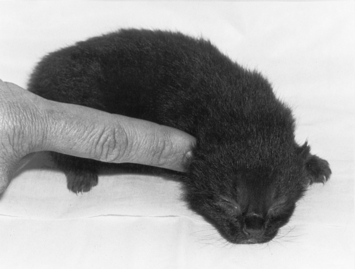
Figure 2-10 The auriculonasocephalic reflex is directed toward the cervical touch stimulus by a day-old kitten.
Tactile placing of the forelimb appears during the first 5 days, almost 3 weeks before visual placing occurs (Figure 2-12). Then, as late as 6 weeks, kittens still show a preference for tactile determination of depth, using vision only secondarily.220 The difference between dependence on the two senses represents the difference in time required for the completion of connections with the motor cortex.268
External tactile characteristics
In adults, areas of tactile dermatomes have been well mapped, but skin sensitivity varies. Pinkus’ plates, specialized tactile pads or touch areas, have been found covering the skin at a rate of 7/cm to 25/cm by the seventh week of age.19,37,151 The cat’s face is approximately one third as sensitive to radiant heat as a human face, although the nasal area can respond to minute changes, as little as a 0.2°C rise or 0.5°C decrease.19,155,156,157 Response in the remainder of the body requires a level of heat change that would be painful to humans, from 6° to 9°C.34,154,156,157 Humans report pain at 44°C, whereas cats react between 51° and 54°C.155 This lack of sensitivity on the trunk accounts for the cat’s ability to sit on a stove or radiator, apparently comfortable, even though its hair may singe. Prolonged exposure to high environmental temperatures (25° to 30°C) results in hypoexcitability, and at temperatures more than 30°C the cat exhibits panting, hyperexcitability, and circling. Cold exposure increases somatic rage (bared teeth) and circling.89 Sensitivity can also vary by age and by the type of nerve ending activated. On the footpads 40% of the fibers are slow to adapt in both adults and kittens. They take a deflection of approximately 0.5 mm to plateau.74 The remaining 60% are fast-adapting fibers, which in adults are more sensitive and responsive than in kittens.74
Tactile vibrissae
As a nocturnal hunter the cat may use touch for stalking or for measuring location. In this regard the special vibrissae transmit sensory information only.192 Each vibrissa is contained in a follicle approximately five times larger than that associated with regular hairs.4 Each has at least one associated sebaceous gland and is attached to striated muscle for voluntary control.4 The follicles have blood-filled sinuses and various types of nerve receptors.4 Impulses have been demonstrated with as little as a 2-mg weight or 5-Å directional movement when the direction of movement of these sinus hairs is opposite the natural slant.49,75 In this way an animal can detect wind and air currents reflected from nearby objects. The loss of these hairs makes the cat more dependent on vision. Facial vibrissae, or whiskers, are located in specific areas (Figure 2-13). Large areas of mystacial vibrissae are present in rows on each upper lip. The dorsal two rows of mystacial vibrissae move independently of the ventral two rows, and their positions vary with movement and behavior.19 A large superciliary tuft is located above each eye. Genal tuft one is ventral to the base of each ear, and a genal tuft two is ventral to each genal tuft one near the angle of the mandible. There is a poorly developed mandibular (submental) tuft on the chin.4,19,72 While the cat is walking, the whiskers project craniolaterally to scan a wide angle. When at rest the cat moves them caudolaterally for a much narrower area. During a greeting, defense, or sniff, these tactile hairs are folded back along the side of the head.37,275
Carpal (ulnar carpal) vibrissae are structurally identical to cranial vibrissae and are found on the caudal surface of the forearm immediately proximocaudal to the carpus. Because the associated nerves are sensitive to a proximal displacement of the tactile hair, it has been speculated that their presence is related to the use of the forelimbs for functions other than ambulation, such as capturing prey.23,192,193
Pain is another tactile-associated response. The pain threshold is the point at which the perception of tissue damage or insult occurs.233 The level of tolerance to painful stimuli varies with individuals.
Earthquake prediction
Before some earthquakes, cats have been reported to undergo behavioral changes. Behavior typical of extreme fear or excitement, including restlessness and piloerection, may be seen in cats even though electric instruments do not perceive environmental changes.9,114 Exactly what the cat detects is unknown, but speculations include variations in electromagnetic fields, atmospheric electrostatic charges, air pressure, ultrasonic or subsonic emissions, the earth’s level, water levels, and gaseous emissions.114 In a comparison of reactions in two similar quakes, the vast majority of animal reactions occurred for the one with a relatively shallow hypocenter, occurring on a strike-slip fault.168
Homing behavior
Cats often go back to a previous home after a move, especially if the old location is nearby. This behavior demonstrates the importance of a territory to a cat. Individuals are said to “run away” during this search, especially if they become lost. Some cats reportedly can travel great distances returning to an old home, and many such trips have been documented. The homing ability is apparently independent of memory, because cats often take a direct route instead of retracing a path. In addition, this directional orientation is not blocked by anesthesia.273 Careful investigations have documented extended trips by cats to meet owners at new locations as far as 1500 miles from the original home.210 Care must be exercised in studying such travels to be sure that the same cat arrives as the one who left. Great similarities in behaviors and physical characteristics can be misleading and are not positive proof of identification. Microchips, tattoos, or rabies tags are necessary for positive identification.
FELINE PLAY BEHAVIOR
Play Behavior Development
At about 2 weeks self-play begins with attempts to bat moving objects. This play progresses with a kitten’s muscle coordination, so at about 3 weeks of age, social play appears as oriented pawing and occasional biting. Within another few weeks interactions with littermates and specific patterns appear. Certain sequences are more common at specific ages.13 By day 35 stalking, chasing, and arching of the back are seen; wrestling appears at day 43.81,261 Climbing and balancing on ledges starts around day 48.170 Leaping is more variable in time of development, ranging from day 17 to 43.81
Social Play
Social play involves two or more cats, and it has eight associated categories of behavior. These behaviors are most prevalent during weeks 4 through 16, and the decline of social play is related to the decreased preference for social contact and the need for dispersal.42,130,265,277 Until week 12, there are no gender differences in the play of kittens, but during the next 4 weeks, differences are seen based on the kitten’s play partner. Female kittens that play with male kittens become more malelike in their play.55 Early weaning and all-male groups have been associated with a higher frequency of social play by kittens.42,171 Initially the various social play postures are highly correlated with each other, but this interrelation is largely lost by 12 weeks.41
“Belly-up” describes a posture of dorsal recumbency with the thoracic limbs making a pawing motion while the pelvic limbs tread (Figure 2-15). The mouth is often open, exposing the teeth. Belly-up, first seen between days 21 and 23, is specific to social play but may occasionally be seen during mating.81 At 6 weeks of age, this behavior occurs during 13% of the social play and at 12 weeks occupies 16% of social play.277
“Stand-up” involves one kitten standing over a second kitten that is in a belly-up posture (Figure 2-16). These two social play patterns appear together 67% of the time. With heads oriented in the same direction, the kittens may paw and bite each other. Stand-up play first appears at about 23 days of age. After this point, up to 15% of social play is devoted to stand-up play.277
A third type of social play, “side-step,” develops at about 32 days of age and occupies 20% of playtime by 6 weeks of age. It involves one kitten showing a lateral body position, including a slight body arch and an upward curve in the tail, to a second kitten (Figure 2-17). Arching peaks at about 6 weeks.41 The posturing kitten then walks laterally toward the second kitten or circles around it.277 This lateral posturing contains many of the same positions later used in distance-increasing silent communication.
In the “pounce” the kitten crouches low with the pelvic limbs underneath its body and its tail straight back (Figure 2-18). Initially the weight is shifted forward and back by the pelvic limbs, which then provide a sudden forward thrust toward the other kitten. This particular social play begins between days 33 and 35 and occupies 42% of a 6-week-old kitten’s play behavior. By 12 weeks, 5% less time is devoted to it.277
From a sitting position, the kitten shifts its weight to its hindquarters, thereby raising its forelimbs perpendicular to the body. By extending the pelvic limb joints into a stationary bipedal position, the kitten assumes the “vertical stance” or “rearing” posture (Figure 2-19). Appearing at about 35 days of age, this posture does not occupy a large portion of play until about 12 weeks of age, when it occurs during approximately 25% of the playtime.277
“Chase” is the social play of pursuit and flight, which develops between 38 and 41 days of age (Figure 2-20).277 This type of activity continues to steadily increase over the next 7 weeks.41 Kittens eventually spend a considerable amount of the play period in pursuit of one another, although at times one kitten runs, and the second fails to follow.
About 5 days after the appearance of chase the “horizontal leap” develops. With body postures like those associated with side-step play, the kitten suddenly leaps off the ground.277
The last of the eight social play categories to develop is “face-off.” By 48 days two kittens sit looking at each other, intensely leaning forward. Simultaneously they direct paw movements at each other’s face. Frequently, however, only one of the kittens participates in a solitary version of the game (Figure 2-21).277
Individual Play
Play behaviors associated with predatory behavior take different forms and may be self-rewarding because kittens will perform them for long periods, even to the point of exhaustion. Isolated kittens play more individually and play with their mothers more than those raised with littermates; object play occurs more often in kittens if the mother was on a rationed diet.16,18,97,177 Object play increases dramatically around 50 days of age in both male and female kittens without littermates or in female kittens with male littermates.15,17 In adult cats, there also seems to be an increased likelihood of play with small objects, especially if the cat has not eaten for several hours.98 Object play may be important as training for solitary hunting, perhaps less so for developing motor skills as for learning important aspects of the situations that accompany the hunt.64
Games of prey perfect some hunting skills and provide exercise. The game “mouse” involves leaping on a small movable object, such as a ball, and securing it with the forepaws while doing body acrobatics (Figure 2-22). In other versions, the paw is used to bat the object. Occasionally two kittens join in this game; one holds the “mouse” as the other bats at it, alternating paws. “Bird” involves intercepting flying objects and bringing them into the mouth (Figure 2-23). Intense interest is directed toward the interception of objects that take off from the ground or that fly from one point to another. Kittens that chase the beam of a flashlight or a laser pointer are good examples of how intense a game of “bird” can become. As skills progress, kittens undertake the game of “rabbit,” in which they ambush large moving objects, such as another cat (Figure 2-24). To succeed is to bring the object to the ground and use the neck bite. Two cats will often alternate between stalking and being chased, but with age the game can become very rough, so the cat prefers a younger or less-animated playmate.32,81
In addition to living and inanimate things, play behavior can be directed toward imaginary objects. During “hallucinatory” play, the kitten leaps at a wall to catch an imaginary object or bats and chases imaginary objects along the ground (Figure 2-25).81 A kitten may express another form of this behavior usually in the early evening by suddenly jumping up with dilated pupils and running wildly around the house as if chasing an invisible kitten.
By 6 months novel objects will attract playful interaction, and the cat exhibits a corresponding reduction in self-play and inactivity.57 The type of toy has a profound effect on whether the activity will continue. Balls are the most desirable play objects.57 Object play may actually be highly linked to predatory behavior, because the more similarities between the object and natural prey, the more predatory-like the play.64 Stress and increasing age suppress play behavior, and adult cats show almost none.
FELINE LEARNING
Development of Learning
Learning is a change in behavior as the result of an individual’s experience.252 It contrasts with instinctive behavior, which involves inherited, species-specific patterns. Although learning behavior in cats, as in other animals, does involve certain genetically determined characteristics of the nervous and musculoskeletal systems, it remains an individual process. Kittens can learn immediately after birth, usually via sensory input. By at least 10 days of age kittens learn to locate a preferred teat for nursing, primarily through trial and error with the sense of smell. It has been experimentally shown that at this age they are also capable of learning to avoid or escape offensive situations (active avoidance).10,71 Passive avoidance occurs when the kitten can identify environmental cues associated with a noxious stimulus and completely avoid the situation. This type of learning occurs sometime between 25 and 50 days.54
In certain situations the cat demonstrates a behavior somewhat unique to the species—observational learning. The queen is responsible for much of this stimulus-controlled response by her kittens. Kittens often do not exhibit an observed behavior immediately after observing the queen perform it, but by 9 or 10 weeks of age, they will suddenly perform the act with the same directness as an individual that has performed it many times.44,211 The importance of imitation is probably variable, depending on the particular action involved.3,25,127 Instinctive imitation, such as the learning of hunting behaviors, is important to mental development and self-preservation. In contrast, the imitation of many voluntary acts requires several observations to learn and a reward to perform. To retain the connection between a previous learning experience and its external stimuli, a cat may imitate the act even though the stimulus is no longer present.25 For example, a cat trained to pull a string for a food reward will continue pulling at a nonexistent string. It is more significant to the cat to watch another cat acquire a response than it is to watch one perform a skill that has already been learned.172 Kittens can use observational learning to push a lever for food but never develop the same skill through trial and error.172 One extreme example of observational learning is an orphaned kitten that was raised with dogs and learned to lift its leg to a tree by observing its male dog companion doing so (Figure 2-26).
Stay updated, free articles. Join our Telegram channel

Full access? Get Clinical Tree


